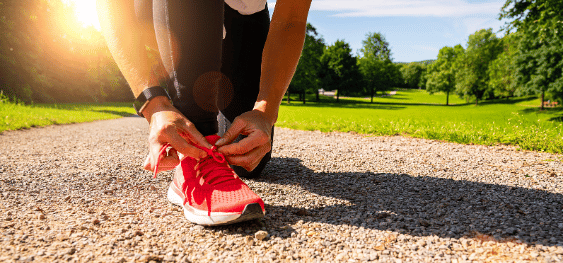By Dr.. Hollie Neujahr, Owner & Founder of N2 Physical Therapy and The Sisu Practice
From my biased perspective, running is one of the best forms of exercise that exist.
Aside from being convenient, affordable, and highly tailorable to your fitness level, it is also a wonderful way to clear your head, relieve anxiety, and be outdoors, amongst others.
At N2 Physical Therapy, our Doctors of Physical and Occupational therapy help runners at all levels returning to running after baby.
We also, based on the research recommendations and within the recommendations of the ob-gyn, work with people during pregnancy to help them continue their activities. Given that the research demonstrates that fear of movement is something that inhibits return to running, I wanted to provide a blog that looks at multiple aspects of returning to running after baby. In this my hope is to respect and present the science, but also provide insights based on being a runner myself, my clinical experience, and the absolute truth that no woman, body, or runner is the exact same and deserves to be treated individually.
To start, I want to emphasize that one size does not fit all.
Did you know that the research shows that feelings of heaviness are more preventative of return to running than a tear? (1). Did you also know that diastasis recti is not associated in the research with low back pain, pelvic pain, or prolapse? (2) The difficulties in the modern world are that social media is not always accurate, classes and training may not always be entirely factual, and marketing targets fear at times. Which sadly, perpetuates the problem: fear of movement. As we do a deep dive into different aspects of return to running, please remember this: cookie cutter approaches should not exist, your options should not be limited due to opinion, and one way for everyone is not healthy and limits the ability to adapt and empower yourself to grow.
We can all agree that every post-partum runner has the potential to have a different history.
Meaning: running performance prior to pregnancy, during pregnancy, and the way that this felt to each person is likely different. Returning to running should be mindful of this, as well as utilzie a biopsychosocial model to tailor a plan for each new mom to reach her goals. Per the evidence, prior relationships to running do matter. Confidence in returning to running matters, as well as the volume of running a person is fitting into the week. From here, we can also utilize logic and clinical experience to design a working program. Each postpartum runner deserves an individualized session with their pelvic health physical therapy in order to determine the best return to sport. Some moms have more support than others to find the time to run, and others might need to be flexible and find ways to include babies in the program. Whatever the situation, moms deserve individualized support with a program that adapts and can be flexible to that mom’s special situation, and that family’s situation.
Barriers to running after a baby might vary based on each individual mom, and the best provider to help that mom is one that is also optimistic, positive, empowering and flexible.
Starting with foundational scientific knowledge, I want to summarize the results of a study of 881 women. This study found that most women returned to running at 12 weeks and 84% experienced pain in the lower limbs, lower back, pelvis, abdomen, breasts, thoracic or coccyx while running. Factors such as running during pregnancy, lower fear of movement, high weekly running olume pre-pregnancy (greater than 10 miles per week), and no vaginal heaviness increase the odds of returning to running postpartum.
A low weekly running volume pre-pregnancy (less than 10 miles a week), lower fear of movement, having more than one child, being younger and shorter time to running after childbirth collectively increased the odds of returning to prepregnancy running levels. Meaning, if a person ran 10 miles a week prior to pregnancy, the odds they would return to 10 miles a week postpartum were increased.
Sometimes the issue might be having attempted running too soon, and generating pain or imbalances. Sometimes it takes too long, because of circumstances out of control, and the motivation is gone. Perhaps there is nerve pain, urinary problems, difficulty with bowel movements, back pain, hip pain – whatever it might be! – Having an individually tailored program, being honest about your goals, is the key to returning to a healthy and positive place.
Running workouts themselves are often inappropriately labeled as “exactly the same.” They do not have to be. Runners like myself know that you’re not going to feel equipped to get out there and tackle a competitive run every day. Maybe you need a recovery jog, an interval run, a speed run, a program for motivation. Perhaps you are doing downhill training for a specific race or hike, or need varied running pathways. Do you have a stroller now that you are navigating? Do you need support for a diastasis? The possibilities of what might empower you to return to running, and when you should return to certain styles or levels of competitiveness with running vary, and finding a provider that you are comfortable with and can work well with is the key. Meeting yourself and your pelvic health PT where you are at is the key to starting any healthy program.
This said, the signs and symptoms you would pay attention to in respect to returning to running are not dissimilar from general signs and symptoms you might watch for in order to feel back to yourself after baby.
To make a self screen more straightforward, I am going to break it down by category:
- Orthopedic problems: Are you experiencing annoying, persistent, or irregular hip pain? Pubic symphysis pain? Abdominal pain? Pelvic pain? Do your feet feel weird, or does your gait pattern feel off?
- Abdominal problems: Do you have increased bladder sensation? A diastasis? Are you feeling less confident about your ab appearance and does this impact how you move? Are you confident? Research does not correlated diastasis rectus with pelvic floor problems, prolapse, or even back pain. I does correlated with a decreased sense of well being, an decreased abdominal control. Are you feeling this?
- Bladder and urinary problems: Are you leaking? Do you have to use the bathroom more frequently? Do you worry that you are going to have to go and there isn’t going to be a bathroom nearby? Are you wet after running and don’t know why? Does your stream seem off, and even hard to start at times?
- Difficulties with your bowel routine: Are you constipated? Are you leaking a little bit in your running shorts or underwear? Is wiping harder, and taking more tissues to get clean? Or the reverse and you feel like you get such strong urges, and more diarrhea style activity, that you don’t want to try a run without knowing where all the toilets are?
- Movement problems: Are you feeling difficulties really coordinating your abdominals? IAP is an important aspect of movement to restore after baby. Do you feel like the hip bone is no longer connecting to the ankle bone? Going through pregnancy puts rapid, intense changes on the spine, hip and gait – then you deliver a baby – and theyr’e just all assumed to go back. That sometimes takes some help and nudging!
- Do you feel ilke things down there are rearranged? Patients often tell me this, and that’s important too. Sometimes it’s hard to articulate exactly what the problem is! Do you feel pressure? Or like something is in a place it shouldn’t be? Does your back feel stuck?
- Has your sex life changed? Does sex feel painful, lowered in sensation? Are you feeling less interested in intimacy?
Most importantly, please know that you can heal these problems, if you are experiencing them.
You only need to build your team, and I would also recommend journaling. Advocating for yourself with your providers on what you are experiencing now that you would like to work on, what you were experiencing before, what new goals you have – embrace it and then you can collaborate and return to running, in the style that is not only safe, but is all about you.
For additional information, N2 Physical Therapy was recently featured in an article by Xero Shoes about how to safely return to postpartum running.
Resources & Further Reading on Returning to Postpartum Running:
- Moore, I. S., James, M. L., Brockwell, E., Perkins, J., Jones, A. L., & Donnelly, G. M. (2021). Multidisciplinary, biopsychosocial factors contributing to return to running and running related stress urinary incontinence in postpartum women. British Journal of Sports Medicine, 55(22), 1286-1292.
- James, M. L., Moore, I. S., Donnelly, G. M., Brockwell, E., Perkins, J., & Coltman, C. E. (2022). Running during pregnancy and postpartum, part A: Why do women stop running during pregnancy and not return to running in the postpartum period?. The Journal of Women’s & Pelvic Health Physical Therapy, 46(3), 111-123.
- My, A. C. O. G., Connection, C., & Rounds, A. C. O. G. (2015). Physical activity and exercise during pregnancy and the postpartum period. Physical activity and exercise during pregnancy and the postpartum period.
- Moore, I. S., James, M. L., Brockwell, E., Perkins, J., Jones, A. L., & Donnelly, G. M. (2021). Multidisciplinary, biopsychosocial factors contributing to return to running and running related stress urinary incontinence in postpartum women. British Journal of Sports Medicine, 55(22), 1286-1292.
- Donnelly, G. M., James, M. L., Coltman, C. E., Brockwell, E., Perkins, J., & Moore, I. S. (2022). Running During Pregnancy and Postpartum, Part B: How Does Running-Related Advice and Guidance Received During Pregnancy and Postpartum Affect Women’s Running Habits?. The Journal of Women’s & Pelvic Health Physical Therapy, 46(3), 124-131.
- Christopher, S. M., Gallagher, S., Olson, A., Cichowski, S., & Deering, R. E. (2022). Rehabilitation of the postpartum runner: A 4-phase approach. The Journal of Women’s & Pelvic Health Physical Therapy, 46(2), 73-86.

